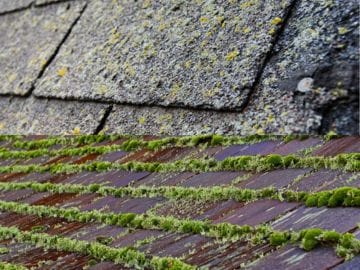When it comes to home maintenance and improvement, the roof over your head deserves a top spot on your priority list, especially if your roof is flat. Flat roofs can have problems.
 Flat roofs are never flat
Flat roofs are never flat
Despite their name, flat roofs should never be flat; they require a slight slope (2%) to drain water efficiently and prevent damage. If your roof is flat, a slope package is the only way to create the required drainage.
Water is heavy
Water is surprisingly heavy. Half an inch of standing water on a 2000-square-foot roof weighs as much as a small car. This additional weight can cause sagging that leads to even more ponding water. This cycle can create a risk of structural failure, an issue that is particularly concerning for older buildings. Ensuring proper drainage is, therefore, crucial to maintaining the integrity and safety of the structure.
Facts about roof membranes
A less obvious but no less critical aspect of roof slope relates to the lifespan of the roof membrane. While flat roof membranes are designed to withstand water exposure, prolonged ponding can severely degrade their performance. Certain materials, such as Thermoplastic Polyolefin (TPO), are particularly vulnerable and may begin to deteriorate when subjected to standing water. Additionally, ponding water amplifies the damaging effects of UV radiation from the sun. Finally, standing water encourages the growth of algae, mould, and moss, which can cause further damage to the roof membrane.
Drainage is necessary
Lastly, implementing adequate drainage through sloping is paramount in leak prevention. A roof draining well is significantly easier to inspect and maintain, reducing the risk of leaks. This helps protect the property from water damage and ensures that any issues can be quickly identified and repaired. In essence, a well-drained roof is a more secure roof, safeguarding against the potential headaches and costs associated with water ingress.
Material options
Several material options are available for constructing a slope on a flat roof, each with unique benefits and costs:
- · Plywood and Dimensional Lumber: Building a slope using plywood and dimensional lumber is a traditional choice that’s well-suited for projects requiring a solid deck surface without additional insulation.
- · Tapered ISO Insulation: On the other hand, polyisocyanurate insulation (ISO) is a type of rigid foam insulation made into flat or sloped panels. The panels can be fitted together to add a slope and enhance the roof’s R-value, making it an excellent choice for those looking to improve thermal efficiency.
- · Tapered EPS Insulation: Expanded polystyrene insulation (EPS) slope packages are custom-manufactured to fit your roof. EPS is the preferred choice for large or complicated roofs. Additionally, the bonus of added insulation value makes it an intelligent choice when additional energy efficiency is desired.
- · Stacked Roofing Membranes: Lastly, layers of roofing membrane can be stacked to create targeted drainage improvement. This involves strategically building up membrane layers to direct water away from problem areas.
Each option offers a unique solution to the challenges of creating an adequate slope on a flat roof, ensuring that homeowners can select the option that best meets their specific needs and goals.
Other factors involved
Several key factors must be considered when designing a slope package to ensure the project’s success. First, ventilation plays a crucial role; if the roof features a cavity, adequate ventilation is necessary to prevent moisture buildup, which can lead to a host of structural and health-related issues. Second, when adding insulation, the condition of the existing vapour barrier is another critical factor. An inadequate or damaged vapour barrier can create condensation problems, compromising the roof’s integrity and the building’s interior environment.
Insulation needs to be examined
Additionally, the state and thickness of any existing insulation should be closely examined. Proper evaluation ensures the roof’s thermal performance meets current needs and efficiency standards, providing comfort and energy savings. Lastly, the design must consider the relative heights of existing roof accessories and any potential obstructions, such as doorways and mechanical units. These elements must be incorporated into the slope design to maintain functionality and ensure that the installation complies with height requirements, safeguarding against water ingress and ensuring the long-term viability of the roofing system. Together, these considerations form the foundation of a successful slope installation, addressing critical structural and performance issues to achieve a durable and practical roofing solution.
Absolute Roof Solutions is a master of flat roofing installation and repairs. We’ve been in the business for over 30 years, and we run a complete training program for our roofing technicians to educate them on the ins and outs of flat roof slopes. You can count on us for all your flat roof needs.









